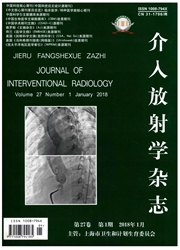

 中文摘要:
中文摘要:
目的 探讨导管室内平板探测器CT(FDCT)技术定量评估肝肿瘤血管生成的可行性。方法25只新西兰大白兔VX2肝肿瘤模型构建后行FDCT检查,重建肿瘤血容量(BV)灌注图,分别检测肝肿瘤和肝实质BV值。FDCT检查后处死所有实验兔,取相应部位肝肿瘤标本检测微血管密度(MVD)和血管内皮细胞生长因子(VEGF)表达,分析肝肿瘤BV值与MVD和VEGF表达的关系。结果 25只实验兔中22只兔(88%)成功完成FDCT检查,BV灌注图均清晰显示肝组织和肿瘤,肝肿瘤表现为高灌注环伴低灌注中心的环状强化模式。肿瘤BV值与MVD和VEGF分级均存在良好相关性(P值均〈0.05),MVD与VEGF分级呈正相关(r=0.504,P〈0.001)。结论 导管室内FDCT检查可定量评估肝肿瘤血管生成情况,可能有助于肝肿瘤介入诊疗。
 英文摘要:
英文摘要:
Objective To investigate the feasibility of quantitatively evaluating angiogenesis in liver tumors by using flat detector computed tomography (FDCT) in the angiography suite. Methods The VX2 liver tumor model was established in 25 rabbits, and then FDCT examination was performed for each animal. After reconstructing the blood volume (BV) perfusion map, BV values of the hepatic tumor and parenchyma were measured respectively. All experimental rabbits were sacrificed after FDCT, and the corresponding tumor specimens were collected for measuring microvessel density (MVD) and vascular endothelial growth factor (VEGF) expression level. The relationships of BV values with MVD and VEGF expression in liver tumors were analyzed. Results Of the 25 experimental rabbits, FDCT examination was successfully accomplished in 22(88.0%). Both the hepatic parenchyma and tumor lesions could be clearly visualized on BV perfusion map. The hepatic tumor was characterized by a hyperperfusion rim with a hypoperfusion center, known as rim-like enhancement pattern, on BV perfusion map. BV values bore a close relationship to both MVD grade and VEGF grade (P〈0.05 in both), while MVD grade had a parallel relationship with VEGF grade @=0.504, P〈 0.001). Conclusion It is feasible to use FDCT in the angiography suite to quantitatively assess the angiogenesis of liver tumors. It may be helpful for interventional treatment of liver tumors.
 同期刊论文项目
同期刊论文项目
 同项目期刊论文
同项目期刊论文
 Differentiation of pyogenic hepatic abscesses from malignant mimickers using multislice-based textur
Differentiation of pyogenic hepatic abscesses from malignant mimickers using multislice-based textur Hepatic Blood Volume Imaging with the Use of Flat-Detector CT Perfusion in the Angiography Suite: Co
Hepatic Blood Volume Imaging with the Use of Flat-Detector CT Perfusion in the Angiography Suite: Co 期刊信息
期刊信息
